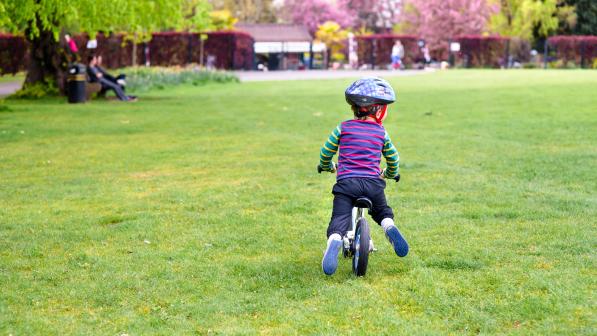Ditching your child's stabilisers when learning to ride

Learning to ride a bike is an important milestone in a child's life, and it often comes with its share of challenges and triumphs. One effective approach to teaching children (and even adults) how to ride is to ditch the traditional stabilisers. Here’s a detailed guide to help you and your child make this transition smoothly and successfully.
Why go without stabilisers?
There are many reasons to ditch the traditional stabilisers or a trike as your child’s first bike. Most cycle instructors agree it’s best to learn to balance first, before moving onto pedalling unaided.
- Improved control: Your child will have more control over the bike and will learn to slow down and stop properly right from the start..
- Better stability: Bikes with stabilisers are often not stable on bumpy or slightly sloping ground and make your child think they are balancing when they are not. This can lead to a habit of over-leaning that they will then have to unlearn when they're trying to ride by themselves without stabilisers.
- Simpler learning process: Once the stabilisers are removed, your child will then have to learn to balance and steer, while also learning how to pedal.
At Cycling UK, we believe the most important thing is that all children learn to ride a bike. We're not saying if you have a bike with stabilisers you shouldn’t use it, but we believe balance bikes provide an easier way to learn.
Karen Gee, founder of the family cycling website Cycle Sprog, highlights that for some children balance bikes aren’t the best option.
"Some children who have issues with balance or mobility find balance bikes difficult to use, so stabilisers can be a good choice. And some children are just desperate to get on a pedal bike, usually so they can be like an elder sibling or parent. However, they can usually be tempted by the speed and fun of a balance bike!"
Step-by-step guide to mastering bike balance
1. Adjust the saddle
Start by making sure that the saddle is low enough so that your child can keep their feet flat on the ground. This position provides a sense of security and helps with balance.
2. Learn how to use the brakes
Before moving on, make sure the rider knows how to use the brakes. This step is crucial for safety and for building trust in the bike's ability to stop.
3. Remove stabilisers and pedals
To mimic the experience of a balance bike, remove the stabilisers and pedals. This allows the beginner to "scoot" along without the risk of hitting their ankles on the pedals.
4. Practice scooting
Spend time scooting around in a safe, open space such as an empty car park or playground. A gentle downhill slope can be particularly helpful. Encourage the rider to look over their shoulder before setting off to ensure the path is clear.
5. Emphasise safety
Explain that if they ever feel uncomfortable or out of control, they should gently apply the brakes and put their feet down immediately.
6. Reattach the pedals
Once they can keep their feet off the ground for a count of 10-15 seconds (using "15 elephants" as a playful measure), it's time to reattach the pedals. This milestone indicates they have developed enough balance.
7. Combine pedalling and balancing
With the pedals back on, encourage your child to start scooting downhill, lifting their feet to the pedals without looking down, and then begin to pedal.
8. Advanced starts
Teach your child to start downhill with one pedal up and one foot on the ground, pushing off strongly with both legs. Over time, they should progress to uphill starts, requiring a more powerful push off.
Notes on equipment and techniques
For younger children
If the child is under five, it's often best to start with a balance bike and let them play on it at their own pace.
Bike weight
Choose a lightweight bike such as those from Hornit, or Frog, which offers Cycling UK members a 10 per cent discount, or Islabikes (Islabikes, sadly, are no longer selling bikes, however they can still be found second hand and spares are available) rather than a heavy one. A lighter bike is easier to handle and less intimidating.
Smooth operation
Ensure that the brakes don’t rub and that the bearings allow the bike to glide smoothly for at least 15 seconds.
Making learning fun
For children, turning the learning process into a game can significantly enhance their engagement and skill development.
- Frogs legs: This game involves pushing off with both legs to glide, mimicking frog jumps, which helps in building strong, even pushes.
- Sea of sharks/Dodge the lobster: Mark an area where the child cannot put their feet down, or they’ll get “pinched” by the imaginary lobster. This encourages them to lift their feet and glide.
As they become more confident with gliding, you can introduce an obstacle course to further hone their skills.
Building confidence in braking
For both children and adults, understanding and trusting the brakes is essential. As the instructor, remind the learner to "squeeze" (for children) or "brake" (for adults) to ensure they use the brakes instead of their feet to stop. This practice helps them feel in control and safe on the bike.
By following these steps and focusing on balance first, pedalling becomes a much easier skill to master. This method ensures a more confident and enjoyable cycling experience. Happy riding!



